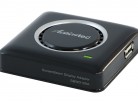First Impressions
Once I opened the box I found a standard sized USB transmitter that is the same size as a USB storage drive, the adapter which is very small, an HDMI cable, the power supply for the adapter, and lastly the software CD. The adapter is smaller than an older iPhone and only has two connections to be made - the HDMI cable and power adapter. Once I plugged the HDMI cable into my TV I was ready to setup my computer. This is a point when I should mention that the directions are very easy to follow. Normally I like to see how far someone can get in an install before they get stuck and need the directions. Surprisingly I got all the way to completion. Once I looked at the directions I found that I had done it right. I setup stuff all the time but I know someone like my mom could setup this device just following the pictures and simple directions.
Setup and Use
For my first test I used an older laptop that has dual CPU's running at 2.0 GHz with 4 GB or ram and upgraded to Windows 7. I had to use the USB transmitter which simply plugs into a USB port and then install the software from the disc or you can download the software online from Actiontec's website. At this point a code will appear on your TV's screen which you need to type into your computer during its setup. After that the ScreenBeam takes over and automatically begins broadcasting your computer's screen onto the TV. I fired up Netflix on my computer and started watching 'Happy Gilmore'. I found the video a little choppy and the audio lagged at times. As I had been using a wireless network I plugged in with ethernet and found that wireless performance makes a big impact on video playback skips. Unfortunately this computer has an older video chipset - things look great on its screen, even movies, but it wasn't designed to give beautiful and true 1080p video. The video was blocky and dark areas tended not to look right. This computer is below the minimum requirements of an Intel CoreDuo at 2.5 GHz or AMD A4+ CPU. I didn't expect to get amazing results but I found that the video was completely usable for video presentations even with this slow of a dual CPU.
Next I fired up my daughter's laptop. This thing is brand new and surpasses the minimum requirements of a Intel Core CPU or AMD A6+ CPU. This computer comes with Windows 8 from the factory and supports Miracast natively. I ran through the setup again which is even easier since I don't have to install the wireless USB transmitter. Once setup the video on the TV screen was stunning. Not only for videos but just for web surfing. I suddenly had a 50" computer display in front of me. Curious I went to YouTube and found that the poor video quality of most of the videos there was even worse in HD. Firing up NetFlix this time with a newer movie in HD I found that the video was every bit as good as what I get from streamed NetFlix from my BluRay player. Better yet - they look as good as DVD. Very impressive. If your source is true HD then you should get a nice HD image on the TV.
Conclusions
If your system has enough power you can get amazing results. Even systems below the minimum requirements can be used for presentations or to beam your computer's screen image onto a larger TV? Why would anyone want to do that? The fastest growing segment of our population are the elderly. I can't imagine a group who could benefit more from having a huge computer screen. The fact that an older computer didn't work well with this device (while streaming video) is more to do with the design of that computer than anything Actiontec did
The wireless used by this device won't interfere with your normal home wireless network and it has built in wireless security protocols to protect it and your data. Now someone can show all those embarrassing home videos from their computer or phone on the TV to a roomful of onlookers. No need to pass your phone around the room. As long as your phone or internet device supports Miracast you can do this easily without the included USB transmitter.
.













